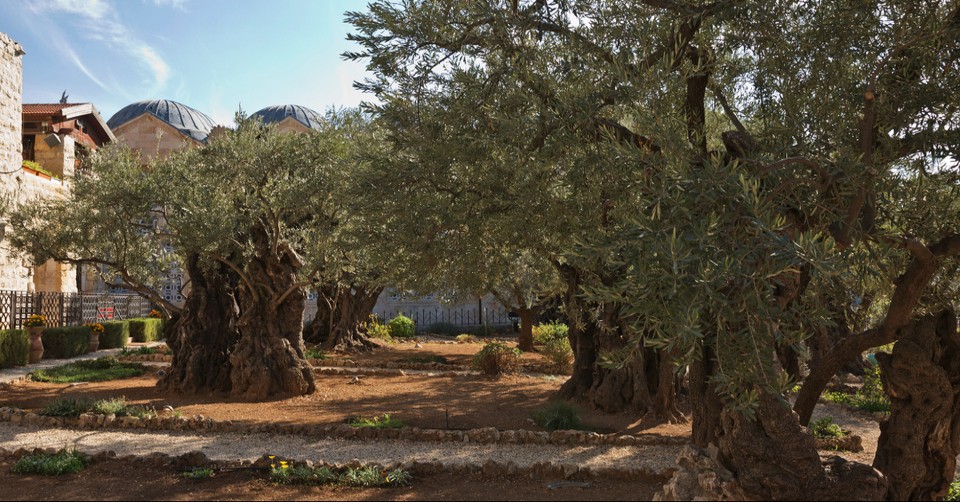Where in the Bible is Jesus' Prayer in the Garden of Gethsemane?

"Then Jesus went with his disciples to a place called Gethsemane, and he said to them, “Sit here while I go over there and pray.” (Matthew 26:36)
After Jesus had instituted the Lord’s Supper with His disciples in the Upper Room, they sang a hymn and “went out to the Mount of Olives” (Matthew 26:30). Each gospel’s account is consistent in the important facts. Yet, the authors add different details, giving further insight into Jesus’ prayer in the Garden of Gethsemane.
Let’s look deeper at Jesus’ visit to the Garden of Gethsemane.
Which Gospels Mention Jesus’ Prayer in the Garden?
The Bible speaks of Jesus’ prayer in the Garden of Gethsemane on the night He was betrayed in Matthew 26:36-46; Mark 14:32-42, Luke 22:39-46, and John 18:1. The synoptic gospels include Jesus’ prayer. John’s gospel only states Jesus and His disciples entered the Garden of Gethsemane and then tells of the entrance of Judas and his detachment of troops and Jewish religious leaders. Notice that all four gospel writers included the story of Jesus entering the garden.
Had Jesus Come to the Garden of Gethsemane Before?
The Garden of Gethsemane is on the Mount of Olives—the same Mount where Jesus preached the Olivet Discourse (Matthew 24-25), and it was one of Jesus’ favorite places to find solitude and pray (Luke 22:39-41). The olive trees would give one shelter and privacy. Gethsemane means “olive press” in Hebrew, and an olive grove still exists near the site marked as to where Jesus prayed the night He was betrayed.
What Happened in the Garden of Gethsemane?
Jesus’ disciples accompanied Him to the Garden of Gethsemane, and He told them to “sit here while I go over there to pray” (Matthew 26:36), and with Him, He took Peter, James, and John—the two sons of Zebedee (Matthew 26:36-37; Mark 14:32-33; Luke 22:40-41).
Each account mentions that Jesus “began to be sorrowful and troubled” (Matthew 26:37). Mark adds He was greatly distressed and troubled and sorrowful “even to death” (Mark 14:34).
Jesus told the three to remain there, watch with Him, and pray they would not be tempted. Yet after He prayed the first two times, He found them asleep, even telling Peter, “So, could you not watch with Me one hour?” Jesus then said, “the spirit is willing, but the flesh is weak.” Scripture tells us “their eyes were very heavy and they did not know what to answer Him.” After His third prayer, He woke them by saying to sleep later, for His betrayer was at hand. (Matthew 26:36-46; Mark 14:32-42; Luke 22:39-46).
Why Did the Disciples Fall Asleep?
What is the significance of the focus on the sleeping disciples (Peter, James, and John)? Luke says Jesus found them “sleeping for sorrow” (Luke 22:45). As humans, we often resort to sleep to assuage fear because sleep is a respite and escape for our minds. The only hint of a rebuke is (as we saw above) what Jesus said to Peter, “So, could you not watch with me one hour?” (Matthew 26:41). Jesus was about to face the greatest trial, and He passed the test of temptation to take the “easy road.” Would the disciples also pass their temptation to escape?
Jesus shows remarkable restraint and patience with His closest friends, and to be fair, Peter, James, and John were undoubtedly confused and reeling from Jesus’ revelation that He would soon die.
Let’s now focus on Jesus’ prayer.
What Did Jesus Pray for in the Garden of Gethsemane?
Matthew’s gospel records Jesus’ prayer in this way:
“My Father, if it be possible, let this cup pass from Me; nevertheless, not as I will, but as You will” (Matthew 26:39).
And a second time in Matthew 26:42:
“My Father, if this cannot pass unless I drink it, Your will be done.”
Jesus, after finding His disciples “sleepy,” left them and “went away and prayed for the third time, saying the same words” (Matthew 26:44).
Mark’s gospel chronicles His prayer as, “Abba, Father, all things are possible for You. Remove this cup from Me. Yet not what I will, but what You will” (Mark 14:36). Mark adds the personal term, Abba, which we can render as Daddy. Mark also mentions Jesus prayed three times.
Luke’s record of Jesus’ prayer is, “Father, if You are willing, remove this cup from Me. Nevertheless, not My will, but Yours, be done” (Luke 22:42). Jesus’ prayer is a perfect model of how Jesus taught His disciples to pray in Matthew 6:10: “Your kingdom come, Your will be done on earth as it is in heaven.”
Matthew 26:44 tells us Jesus prayed the same prayer three times, and each time, He prayed for this not to happen, yet without objecting to the Father’s will. The temptation for Jesus in the Garden of Gethsemane did not lay in the possibility of disobedience; it lay in the option of compromising, doing the Father’s will the easy way.
Jesus was the final Passover Lamb to be slain. Even though He did shrink back from the suffering, He ultimately yielded to the Father. He knew the union of the Trinity would be broken, albeit temporarily, as He endured the Father’s divine wrath poured out on Him. The crucifixion would be the first and only time the Father looked away from the Son, because the sins of all people throughout all time—past, present, and future—would be laid on Jesus at Calvary,
The cup to which Jesus referred was a common symbol for divine wrath (Psalm 11:6; Isaiah 51:17; Ezekiel 23:33). Why did Jesus need to bear the Father’s wrath? Isaiah 53 gives us the answer. Jesus was “pierced for our transgressions; He was crushed for our iniquities; upon Him was the chastisement that brought us peace, and with His wounds, we are healed” (Isaiah 53:5).
The Father answered the Son’s prayer—not to remove the cup—but to empower Jesus to complete the plan made before time began. Jesus knew what was to come at the cross. He also knew what would come after Calvary—the resulting joy (Hebrews 4:16, 12:2).
Did Jesus Really Sweat Drops of Blood?
Never before had Jesus’ disciples heard such prayers before or seen their Master in such anguish, and Luke’s is the only gospel that mentions, “His sweat became like great drops of blood falling down to the ground” (Luke 22:44).
Luke was a physician, and he would have included details that speak to his vocation. We do not know if Jesus sweated blood because the Scripture says, “like blood,” not “His sweat became blood.” However, a condition exists (hematidrosis), which may happen to people who suffer from tremendous levels of stress. Multiple net-like blood vessels encircle the sweat glands, and they compress under the pressure of great stress.
The fact is Jesus endured intense tension, most likely greater tension than any human could, and that is the focus of our wonder.
What Can We Learn from Jesus’ Prayer in the Garden?
Scripture always speaks the truth, and the lessons we learn from Jesus in His time in Gethsemane are too profound to ignore. Here are a few of the vital lessons we can learn:
We are weak, but Jesus is greater than all our limitations. (1 John 4:4)
Our spiritual health is not derived from ourselves. It is in Jesus and His Spirit within us. (Isaiah 53:5)
Jesus understands all our weaknesses. (Hebrews 4:15)
Prayer is paramount in all circumstances. (Philippians 4:6)
God’s will is perfect. (Proverbs 3:5-6)
We can surpass temptation. (1 Corinthians 10:13)
Seek first the kingdom. (Mark 14:36, Matthew 6:33)
God is patient with us. (2 Peter 3:9)
The time Jesus spent in Gethsemane also gives us an encouraging reminder about the beauty of the Incarnation: God has experience struggles too. Greg Laurie explains how we see this beautiful truth in the Gethsemane story:
Before there was a Calvary, there was a Gethsemane. The sorrow Jesus experienced in the Garden of Gethsemane on the last night before His crucifixion seemed to be the culmination of all of the sorrow He had ever known, which would accelerate to a climax the following day. This time at Gethsemane, next to the cross itself, was the most difficult moment of His life. He underwent stress of cosmic dimensions.
We must remember this in our moments of loneliness, when we feel as though we have been abandoned by friends or perhaps even betrayed by our own family. When you feel as though no one cares about you, you have a glimpse of what Jesus went through. Jesus experienced all of that—not only the betrayal of His own disciples, not only the people turning against Him en masse, but also the Father himself turning His face away from Jesus for a time as He bore all of the sins of the world—past, present, and future. So Jesus has been there. He knows what it is all about.
Hebrews 4:15 reminds us, “This High Priest of ours understands our weaknesses, for he faced all of the same testings we do, yet he did not sin.” Don’t think you are talking to a God who doesn’t care or is disconnected. To the contrary, Jesus has experienced it. He has felt it. He knows it. That is why verse 16 says, “So let us come boldly to the throne of our gracious God. There we will receive his mercy, and we will find grace to help us when we need it most.”
We will have Gethsemanes in our lives, so to speak, times when life isn’t making any sense. That is when we need to remember that Jesus has been there too.
Taken from “Been There” by Harvest Ministries (used by permission).
Photo Credit: GettyImages/jirivondrous

This article is part of our larger Holy Week and Easter resource library centered around the events leading up to the death and resurrection of Jesus Christ. We hope these articles help you understand the meaning and story behind important Christian holidays and dates and encourage you as you take time to reflect on all that God has done for us through his son Jesus Christ!
What is Lent? It's Meaning and Why We Celebrate
When is Lent? When Does Lent Start and End?
What is the Meaning Ash Wednesday?
What is Holy Week?
What Is the Meaning of Palm Sunday?
What is the Meaning of Holy Monday?
What is Maundy Thursday?
What Is Good Friday and Why is it Good?
Good Friday Prayer
What Does Holy Saturday Mean?
What Is the Easter?
Easter Prayers
Powerful Facts About the Cross of Jesus
Originally published February 15, 2024.







